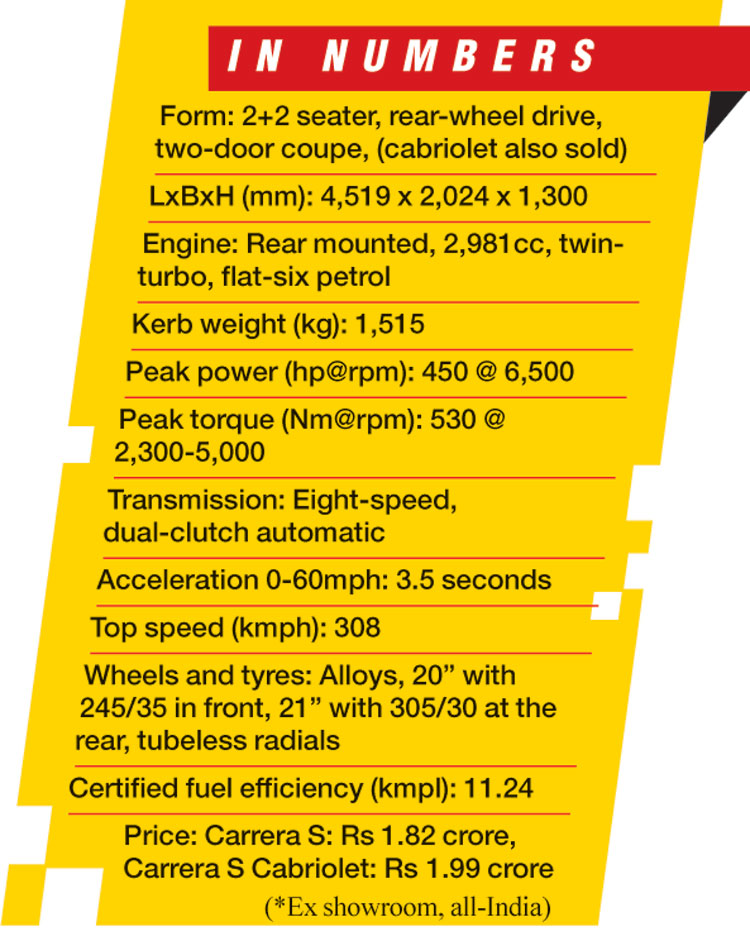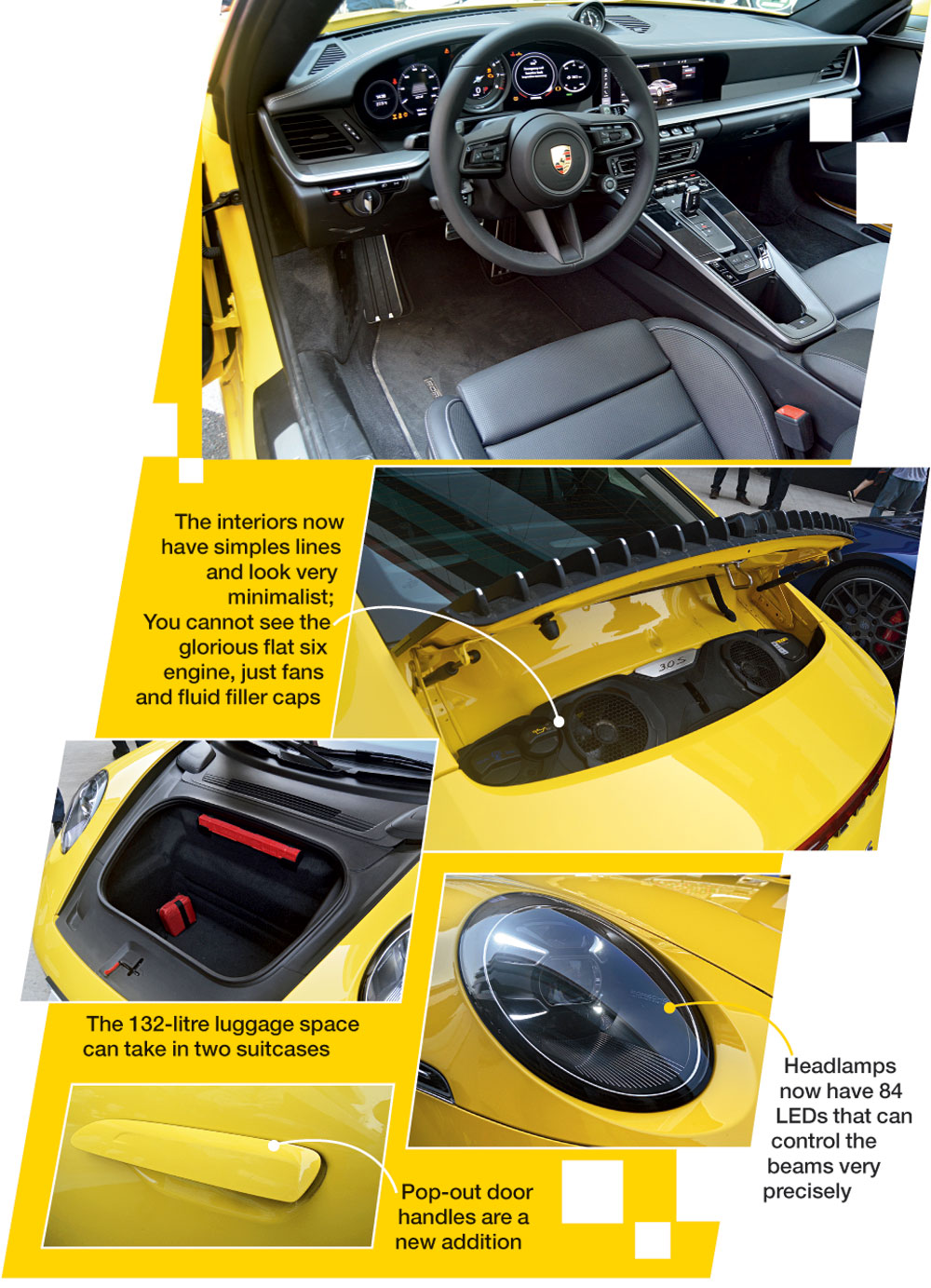The more things remain the same, the more they change. And it is rarely truer of any other car than the Porsche 911. The first-generation model was introduced more than 50 years ago, back in 1963, and the car is now into its eighth generation, the model going by the company’s internal code name of 992. And it is this newest model in the Carrera S version that has been introduced in the Indian market a couple of days ago.
The Telegraph got to take it for a spin on the Buddh Interternational Circuit (BIC) racetrack in Greater Noida right after the launch. This was possibly the best and safest place to push the 911 into performance territory where one can really figure out what it’s about and whether it lives up to the expectations one has of a car that has 911 written across the back. And there is no way we could have checked out the dynamic capabilities any better, for the track allows the car to be driven as hard as the driver dares without worrying about breaking rules or risking life and limb.
So here are the first impressions.
THE EXTERIOR
Anyone who has ever seen a 911, will immediately recognise the new car as one. In fact, it looks so close to its predecessor that while it does look different at closer inspection, one could actually find it hard to spot the exact changes unless he has a keen eye.
This, however, is an entirely new car and is the first one built on Porsche’s MMB platform. Unlike the earlier generation cars, where the two-wheel drive cars would have a narrower rear end than the four-wheel drive ones, the new car holds the width uniform for all versions.
Up front, the three-section air intake is now all continuous black without the body-coloured vertical sections of the earlier model. That gives the car a wider and lower-slung look. A similar black section is now on the rear bumper too and houses the exhaust pipes as well. Interestingly, the louvres on the intakes on the side open or close depending on whether more cooling is needed for the radiators that sit behind them or more slipperiness through the air for the car to achieve better fuel efficiency or higher speeds.
The bonnet, which is actually the bootlid because the engine remains at the back, is now flatter and has a recess in the middle that harks back to the first-generation model. The headlamps are different, too, and use the latest LED technology. There are 84 of them and smart enough to illuminate bright bits, like signs that are too shiny, less than darker bits. The stacked pattern of the earlier car has made way for a central light and four sets around it.
On the flanks the grab handles for the door have made way for pop-out type ones that sit flush with the body when not in use.
It’s round the back that the changes are more evident. There is now an LED light bar that curves right across the back from one tail lamp cluster to the other. Also, the two central strakes on the engine cover are now additional brake lights that look quite distinctive.

The Telegraph
THE INTERIORS
The overall idea of adding visual width to the 911 continues on the inside as well. The dash has very strong horizontal elements that wrap themselves around the driver and front passenger. Everything that looked remotely fussy has been made to look smoother and sleeker. Even the earlier door handles that had a sort of ring which made using them very easy have been jettisoned for flush
L-shaped ones with a rather strong spring action.
And someone seems to have taken a vacuum cleaner to the central console and sucked out a whole array of buttons and the old gear lever in the bargain! A whole lot of functions have now moved to the 10.9-inch central touchscreen on the dash. In fact, it seems very similar to that on the latest Cayenne and Macan SUVs.
The gear lever is now a little stub that’s probably about a shade bigger than the key fob. Those who like driving in manual mode, therefore, will have to get used to using the paddle shifters to do so.
A big break with the past is the instrument cluster. The signature central tachometer remains analogue, but the other four of the signature Porsche five-dial setup have crossed into the digital world. There are two screens on either side of the tacho that can now be customised to look like the now-gone dials, or set up to show other information depending on what is desired.
The multifunction steering wheel is the perfect size and has drive-mode selector dial. The Wet mode is an addition here and the car can prompt the driver to use it when it senses water below the tyres. The steering is very quick and direct and despite being power-assisted electrically, transmits a lot of feel of the road.
One sits low in the 911 but once inside everything fits nicely with the side bolstering of the thinned-down seats holding both driver and passenger snugly in place. The seats, too, are thinner now. This being a 2+2 sportscar, the rear seats are best left for children.

Pictures: Abhijit Mitra
THE DRIVE
Traditionalists might lament the fact that the five-dial instrument cluster and the option of shifting using the gear lever are no longer available, abstracting from the tactile feel of the 911. What is crucial, however, is how it drives, or, more importantly, does it still drive “like a 911”. Out of the pit lane at the BIC, we just needed to mash the pedal to the metal in the Sport Plus mode for the car to squat down on its ample haunches before launching itself into the mood of things and charging down to Turn One.
Brake, turn in, kiss the apex and power out again into the long left-hand curve into Turn Two and the automatic allows the revs to climb before shifting up in the Sport Plus mode. Brake again, we did a shade late and powered out using the width of the track onto the long back straight. Keep it floored and the revs climb again and so does the speed. A chicane had been created around the middle to break the rush, but still we hit about 180kmph and danced through the chicane without even a blip, those wide, wide low-profile Michelins keeping the nose pointed exactly where one wanted it to go. We were beginning to grin, but there was more to come.
A sharp right at the end of the straight followed by a shorter one — once again broken up by a created chicane — led into a double left and the car went from apex to apex like a dream, with the big new turbochargers adding a fantastic soundtrack to the action as the engine went from baritone to soprano and back with a couple of blats and pops thrown into the mix. The steering is so good that you could possibly even use it to guide surgical arms if you wished.
On the long and neverending curve at the far end of the track it was totally home. Later, in the hands of one of the expert demonstration drivers, it just went sideways through many of the turns, losing a bit of speed in the process but adding dollops of fun. In fact, if you kept a bit of distance to the preceding car, most of the time one did not need to brake too hard into many of the turns. The car can carry huge amounts of momentum through the corners.
The interesting bit is while we were doing most of the distance with the hardest suspension setup — there are three levels — and in that we could feel the undulations on the concrete in the paddocks through the seat, in Normal mode this is one car that can even be a daily driver for someone using it with a light foot. One had better, for there is 450hp and 530Nm under the right foot and minor indiscretions could lead to major losses.
Unfortunately, with some restrictions on the driving we could not get too close to the 308kmph top speed. But that said, it is in the turns that the 911 delivers maximum joy and we had a whole bunch of those to go through.
Incidentally, we got to drive the European spec left-hand drive version, but the one that will be sold in India will come in right hand drive.
THE DECISION
At Rs 1.88 crore for the 911 Carrera S and Rs 1.99 crore for the Carrera S Cabrio (we did not see this one), which now has the same roof profile as the hardtop, the new Porsche 911 doesn’t come cheap. And as an option for a car to go from Point A to Point B, there are, as Calvin would put it, a gazillion alternatives. So do you ‘need’ a 911? The short answer is ‘No’. But would you ‘want’ one? Hell, YES!











